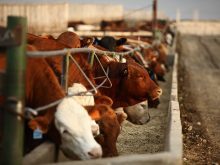Chicago | Reuters – Chicago Mercantile Exchange live cattle futures firmed on Wednesday, underpinned by stronger cash trade as packers pull more cattle forward, while wholesale beef prices added support, analysts said.
“It does seem like the packers have picked up the production for cattle lately,” said Doug Houghton, technical analyst at Brock Capital Management. “Feedlots are likely getting more current on marketings.”
December live cattle futures firmed 1.700 cents at 131.650 cents per pound after reaching 132.400, its highest since Sept. 3. The most-actively traded January feeder cattle contract rose 2.200 cents to settle at 159.225 cents per pound.
Read Also

Canadian cattle groups look to renew national organization
Canadian Cattle Association review and potential reset were the focus of a two-day meeting of nine provincial beef associations.
Cash cattle traded at $128.00 per cwt. in Kansas, Texas and Oklahoma, up $2.00 from a week earlier, according to the U.S. Department of Agriculture, while daily cattle slaughter held steady at 122,000 head. Wholesale beef firmed, with select cuts adding $1.59 to $267.72 per cwt., while choice cuts gained $1.11 to $288.49 per cwt, the USDA said.
Lean hog futures also firmed, supported by firmer pork cutout and tight hog supplies, Houghton said.
“The cutout strength held today,” he said. “It would suggest seasonal demand for hams ahead of the year-end holidays.”
In CME lean hog futures, the benchmark December contract settled 1.700 cents higher at 75.950 cents per pound. February lean hogs closed the day up 1.400 cents at 78.550 cents per pound.
The CME’s lean hog index, a two-day weighted average of cash hog prices, fell 0.120 cents to $79.04 cents per pound, still premium to December futures.
Increased demand for pork heading into the year end could offer a floor to hog futures, Houghton said, though ongoing labor issues and federal regulations slowing processing line speeds continue to pressure the market.















